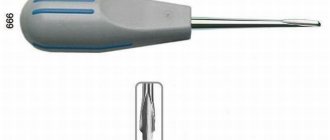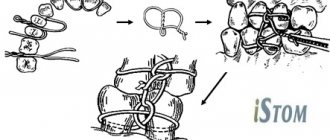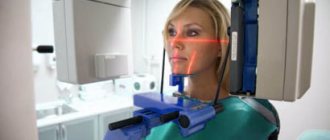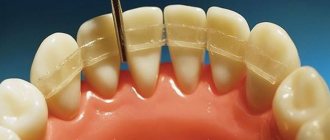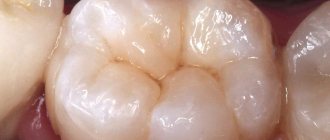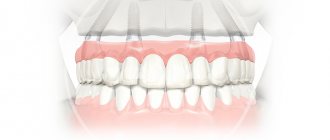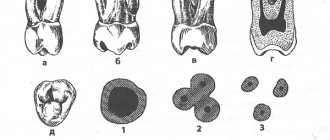Any injury to the bones of the skull is extremely dangerous. The jaw is most often affected; young men aged 18 to 40 are at risk. Fractures of the upper and lower jaw require serious and immediate treatment
, so it is very important to contact a specialist in time.
Main causes of jaw fracture
Such pathologies arise under the influence of mechanical stress on the bone, the force of which exceeds its strength. Most often, fractures of the maxillofacial region (MFA) occur in the following cases:
- Road traffic accidents.
- Extreme sports.
- Pronounced physical impact.
- Firearms.
Not everyone who finds themselves in such unpleasant situations suffers a broken jaw. The skull bones are very strong, so the incident must be really serious. True, there are people who are more susceptible to non-gunshot fractures of the lower and upper jaw than others.
If the following conditions are present, the bones of the skull break more often and more easily:
- Oncological diseases.
- Inflammatory processes in bone tissue.
- Infectious diseases, especially tuberculosis.
- Taking certain medications.
- Impaired bone mineralization.
- Metabolism problems.
- Acute deficiency of vitamins and microelements.
Consequences and complications
The consequences of a jaw fracture include complications, both early general ones in the form of mental and neurological disorders, and the development of life-threatening pathologies of the circulatory, respiratory and other systems. Preventing their occurrence is the prerogative of the maxillofacial surgeon, working in collaboration with other medical specialists.
Local complications related to the oral cavity include:
- sluggish consolidation of fragments;
- development of temporomandibular joint dysfunction and traumatic osteomyelitis;
- the formation of a suppurating hematoma, the appearance of lymphadenitis, abscess, phlegmon.
The development of sinusitis and the formation of other sources of chronic infection of the body lead to no less serious consequences.
Symptoms of a jaw fracture
A bone fracture is always painful, so it is impossible not to notice it. And yet, people sometimes confuse the signs of a jaw fracture and a dislocation and, not realizing the seriousness of the situation, try to solve the problem at home. To correctly identify an injury, you need to know its main symptoms:
- Pain that intensifies when touching the chin and any movement of the jaw.
- Unnatural bone mobility.
- Malocclusion. In many cases, a person cannot close his jaw at all.
- Photo: spaces between teeth due to a jaw fracture
Gaps almost always form in the dentition.
- In most cases, teeth break or fall out.
- Changes in the relief of bones, especially in the chin area. The injury noticeably displaces him.
- Hematomas and bruises appear on the face and in the oral cavity.
- Increased salivation.
- Recession of the tongue.
- In most cases, the patient is completely unable to speak, eat or move his jaw normally.
- General malaise occurs. The patient suffers from headache and dizziness. Sometimes the temperature rises and drowsiness appears.
All these symptoms can be considered general. They are typical for any type of similar injury, but there are also narrower signs on which the classification of fractures of the lower and upper jaw depends.
Types of zygomatic bone fractures
In accordance with the accepted classification, there are several types of fractures, for differentiation of which various criteria are used:
- The presence or absence of displacement, which determines the severity of the damage;
- The area of localization of the injury;
- The period that has passed since the damage occurred;
- Single or multiple, as well as one- or two-sided nature of the injury;
- The specificity of the line along which the fracture runs (straight or oblique).
Characteristic signs of pathology include:
- Limitation of jaw mobility;
- Pain that occurs when trying to open your mouth;
- Distortion of the facial contour and deformation of the bone structure;
- Hemorrhage into mucous tissue, eyelid structure, or conjunctiva;
- Bleeding from the nose from the side of the injured cheekbone;
- Visual disturbances, swelling of the areas around the eyes, severe headache.
At the first suspicion of a fracture of the zygomatic bone, you should consult a doctor and undergo a comprehensive diagnosis.
Classification of jaw fractures
Experts distinguish more than a dozen different types of fractures, and the treatment of the patient depends entirely on whether the injury belongs to one type or another. First of all, fractures of the lower and upper jaw can be distinguished, but these groups are also divided into several smaller ones depending on a number of signs.
Types of jaw fractures by severity of injury
- Closed fracture. It damages the bone, but the surrounding soft tissue remains intact. This type of pathology is less dangerous, since the treatment lasts relatively short. A non-gunshot closed fracture of the lower jaw heals without complications in 3–4 weeks.
- Open fracture. Bone fragments can move to the side and damage soft tissues, blood vessels and joints. This pathology can be recognized by severe bleeding. Open fractures of the lower jaw are more common.
An open injury is doubly dangerous, since it carries a high risk of bacterial infection and severe blood loss. Medical assistance must be provided immediately.
Types of jaw fractures based on displacement of fragments
- Fracture without displacement. With such an injury, the bone can even be divided into multiple fragments, but they are in a standard position and do not move relative to each other. The crack may be incomplete. Injury is easier to treat and carries with it minimal consequences.
- Displaced fracture. In this case, the jaw fragments change their position, which causes additional pain and complicates treatment. With open injuries, the bone is always displaced.
A displaced fracture of the lower jaw is more common than the same injury to the upper part of the skull. Damage can be recognized by severe swelling and facial asymmetry. - Comminuted fracture. The bone splits into separate fragments of different sizes, which are arranged in a chaotic manner. In most cases, the pathology is accompanied by damage to soft tissues and requires immediate medical attention and long-term treatment. Often, after hospitalization, patients also have to see a plastic surgeon.
Types of jaw fractures by location of injury
The types of fractures of the lower and upper jaw are determined not only by symptoms, but also by location:
- A midline fracture is located in the middle of the bone.
- If the injury is located near the lateral incisors, it is defined as incisive.
- A canine fracture is an injury to the third teeth of the upper or lower jaw.
- A crack in the chin area is designated as mental. It is one of the most common jaw injuries due to the fact that a person's chin protrudes noticeably.
- An angular fracture can only occur in the lower jaw. It is located in the corners of this bone, closer to the base of the skull.
Doctors may use a more extensive classification of such injuries. It’s even difficult to imagine exactly how many types of pathology there are - each case is individual in its own way.
Lefort classification
There are three main types of Lefort fractures of the upper jaw, the severity of which increases from 1 to 3. Each type has its own characteristics, which need to be understood in more detail.
The first type is also called an inferior fracture and is characterized by the passage of the line of damage above the alveolar process and the hard palate. Next, the fracture line follows along the lower edge of the pyriform opening and along the bottom of the maxillary sinus. Guerin was the first to describe such an injury; a fracture occurs when a blunt object hits the upper lip. In the literature you can find Guerin-Lefort damage.
The second type is called a suborbital or midline fracture. The difference from other injuries is that the upper jaw is broken off from the rest of the facial bones. The fracture line passes through the root of the nose (the junction of the process of the upper jaw and the frontal bone). Next, the line runs along the base of the orbit, through the zygomatic suture and to the sphenoid bone posteriorly. The cause of damage may be a blow to the bridge of the nose.
The third type of fracture is the most complex; it is called superior or subbasal. The upper jaw is torn off along with the cheek bones from the brain part of the skull. The fracture line runs from the base of the nose (the junction of the frontal bone and the processes of the upper jaw) further to the orbit. The cause of such a fracture is a blow with a blunt object to the area of the eye sockets or base of the nose, to the cheekbone.
Additionally, the classification of fractures of the upper jaw includes open and closed types. Open injuries include injuries where there is a wound or crushing of soft tissue. It is also worth talking about the open type when the fracture line affects the mucous membrane or tooth.
First aid for a broken jaw
The very first thing to do if a person breaks their jaw is to call an ambulance. After this, measures can be taken to alleviate the victim’s condition:
- Since damage most often occurs in the event of an accident, fights, or falls, first of all you need to make sure that the person’s life is not in danger.
- If there are several non-gunshot injuries, the jaw should be addressed first. The exception is open fractures of other bones if the head injury is closed.
- If there is bleeding, apply a clean, preferably sterile, cloth to the wound. If the damage is minor, cotton wool will do.
- If the patient is unconscious, carefully turn him on his side. Clear your mouth of blood clots and vomit. This must be done extremely carefully, wrapping your finger in a clean cloth.
- Then you should put the patient in a comfortable position and try not to move him anymore. If the patient is conscious, a sling-shaped bandage is applied to the broken jaw, as in the photo on the right.
- Ice is applied to reduce pain. If possible, it is worth giving the victim painkillers. In this case, an intramuscular injection will be most effective. Analgin, Naproxen, Revalgin are suitable tablets.
Since the patient is unable to swallow, the painkiller tablet must be crushed and dissolved in water. If the person is unconscious, you can pump the liquid into a syringe without a needle and gently pour the medicine directly down the throat.
Treatment of a jaw fracture
Splinting
Once the patient is admitted to the hospital, he is sent for an x-ray to find out if the jaw is broken and to determine the exact location and severity of the injury. The stages of treatment depend on the classification of the fracture. In most cases, splinting will be done, but additional therapies may be prescribed.
A special plastic device or wire structure is placed on the jaw on the damaged side. In case of injury on both sides of the bone, a more complex and rigid product is used. After installing the structure, a series of loops are formed in the smile area. The hooks on the upper and lower jaws are connected by elastic bands.
The main task of splinting is to maintain the immobility of bone tissue for exactly as long as the jaw fracture heals. Treatment usually lasts from 3 weeks to six months.
For displaced angular injuries, a bone suture is required.
To do this, the crack is exposed from soft tissue, and small holes are made in the bone fragments along the entire length of the fracture. Then the parts are connected to each other with a special wire and covered with soft cloth.
After the main operation, rehabilitation begins. For faster tissue regeneration, magnetic therapy, ultraviolet irradiation, calcium electrophoresis at the fracture site, or other therapeutic procedures are used.
Treatment of a jaw fracture at home
After 3–4 weeks, if the fracture is uncomplicated and the person is no longer in danger, he can be discharged from the hospital.
Usually by this time the bone has not completely healed, so the specialist gives a number of recommendations for continuing treatment at home:
- For an open fracture of the jaw, antibiotics are prescribed; after discharge from the hospital, you need to continue taking them at home.
- To speed up healing, multivitamin complexes rich in calcium and substances that improve its absorption are prescribed.
- You can treat a crack in the jaw with folk remedies, but before using them you need to consult a doctor. Most of all, experts approve of paraffin therapy.
- After removing the splint, you will have to wear a special fixing bandage for several months - first it is worn all day, and then only at night.
- If the splint has already been removed, the jaw needs to be developed. Every day for a few minutes a person should do simple exercises: move his jaw from side to side, open and close his mouth wide.
All of the recommendations listed can only be used as a supplement to the main treatment that takes place in the hospital. It is impossible to cure a fracture without medical help.
Nutrition for a jaw fracture
Due to the injury, the process of eating becomes more difficult, because it hurts the patient to even open his mouth, not to mention chewing. And yet a person must receive a sufficient amount of nutrients. This determines how long it will take for a crack in the jaw to heal. If there is a deficiency of nutrients, the treatment period increases and more complications appear, so the patient is fed according to certain rules:
- A rubber tube is inserted directly into the patient's throat, through which a nutrient solution or liquid food will be administered. Usually the tube is placed through an area where one or more teeth are missing, which happens quite often when the skull bones are damaged. If there is no gap, then the tube is placed in the mouth through the gap after the wisdom tooth. Such nutrition is convenient because it is possible even at home.
- If a patient with a jaw fracture is in intensive care, doctors make droppers with a special solution rich in nutrients, vitamins and minerals. If this is not possible, a nutritional enema is used.
- The basis of the diet is ground meat mixed with milk or broth, baby food, pureed soups, fruit and vegetable dishes, and liquid porridges.
- The patient will need more calories than he normally needs. In addition, the vitamin and mineral value of the diet increases.
Consequences of a jaw fracture
Such a complex injury cannot go away without a trace; even with proper treatment, certain complications are present:
- Deformation of facial features. Asymmetry arises, sometimes very noticeable (see photo). Typically, this consequence occurs when the jaw is fractured with displacement. With less dangerous pathologies, such a change is almost imperceptible.
- Loss of teeth and their curvature. In many cases, gaps form between the teeth and the bite is disrupted.
- The remaining teeth may become loose when chewing, most often this phenomenon occurs after an angular fracture.
- The vast majority of patients experience jaw crunching after treatment for a fracture. Moreover, this can last until the end of life.
- Due to liquid nutrition, problems with the gastrointestinal tract arise.
You need to understand that a head injury is always dangerous. Only correct and timely medical care will reduce the number of consequences to a minimum.
First aid
In a situation with a serious injury, the people around him must provide first aid to the victim. Medical recommendations exclude independent adjustment of individual parts of the skull or contact with open wounds. The main tasks are to create conditions of complete rest, eliminate re-injury, try to stop the bleeding and call an ambulance team.
In case of acute pain, an injection of an anesthetic is allowed. To stop continuous bleeding, it is necessary to press down the artery. In cases where the wound is small, you can treat the area with hydrogen peroxide, as well as ensure careful application of cold.

